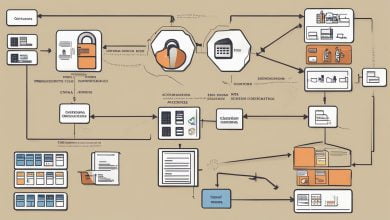
Software design is a constantly evolving field that requires adaptability to keep up with the changing needs and expectations of users. In this pursuit of flexibility, the concept of decorator patterns has emerged, providing developers with a way to add responsibilities to objects dynamically.
Decorators allow for the enhancement of an object’s functionality while keeping its structure intact. This approach promotes scalability and maintainability, making it popular among object-oriented design patterns. In this article, we explore the ins and outs of decorator patterns, their benefits, and real-world applications.
Key Takeaways
- Decorator patterns enable the dynamic addition of responsibilities to objects, promoting efficient software design.
- Decorators enhance an object’s functionality without modifying its structure, allowing for seamless scalability and maintainability.
- Real-world applications of decorator patterns showcase their practicality and effectiveness in modern software development.
Understanding Decorator Design Pattern
The decorator design pattern is an object-oriented design pattern that allows for adding new responsibilities to an object dynamically without affecting its existing structure. This design pattern is particularly useful when extending objects, as it enables developers to decorate or wrap objects with new functionalities at runtime.
The primary objective of decorator patterns is to enhance the functionality of objects by adding new responsibilities dynamically. This approach promotes easy modification of code and enhances the reusability of objects within a system. It eliminates the need to create multiple subclasses within a system to cater to different functionalities, thus making the code easier to maintain.
In decorator patterns, objects are decorated with new functionalities by wrapping them with a decorator class that inherits the same interface as the original class. The decorator class adds new functionalities to the object, which can be further decorated using other decorator classes to extend its functionalities further. This process can be repeated multiple times, leading to a dynamic chain of decorators that enhance the functionality of the object.
Implementing Dynamic Object Decoration
The implementation of dynamic object decoration using decorator patterns is relatively straightforward. To start, define a component interface as the basic building block for objects (the component), which will be extended via decorators. A decorator will implement this same interface while also holding an instance of the component it is extending. This allows for the dynamic addition of responsibilities to an object during runtime.
A key feature of the decorator pattern is that the decorators themselves have an open-ended structure. Meaning, new decorators can seamlessly be added to the existing structure without impacting the underlying component. Any decorator can further extend the object, and the resulting structure will be a composition of multiple decorators and the component.
Object-oriented design patterns provide developers with a set of best practices for building software systems. Decorator patterns are just one example of a design pattern that enables dynamic responsibilities. This pattern is especially useful when you want to add responsibilities to an object without changing its signature or distribution. It also provides a better alternative to subclassing when it comes to extending objects.
To implement dynamic decoration, you can simply add new decorators on the go. You can stack up multiple decorators to produce complicated functionalities. It’s a powerful approach that offers flexibility and helps developers to create a well-organized, modular, and extensible code base.
Real-world Applications of Decorator Patterns
The decorator pattern offers a versatile approach to software design, enabling developers to add dynamic responsibilities to objects at runtime. This design approach has a broad range of applications and can be particularly effective in scenarios where complex, multi-layered functionalities are required.
Web Development and Dynamic Object Decoration
In web development, decorator patterns can be useful in implementing complex content management systems. For example, a decorator can be used to add new features to web pages, such as user authentication and role-based access control, without modifying the original web page’s structure.
The decorator pattern can also be applied to web development frameworks. For instance, the Java Servlet API provides a decorator pattern for filtering HTTP requests before sending them to a servlet. The developer can use different filters to carry out tasks such as authentication, logging, and data validation.
Graphics and Dynamic Object Decoration
In graphics, decorator patterns can be used to modify the behavior of objects by adding new properties dynamically. This approach can be particularly useful in developing large-scale graphic design applications. For instance, in a drawing application, decorations can be used to add new styles to shapes or modify their properties without explicitly changing their structure and design.
Mobile App Development and Dynamic Object Decoration
Mobile app development can also benefit from the decorator pattern, especially in scenarios where users need to configure their app’s behavior dynamically. For example, the decorator pattern can be used to add new features or functionalities to a mobile app at runtime. This approach can simplify the development process and reduce the risk of code errors.
Overall, the decorator pattern provides a dynamic and efficient approach to software design. Through dynamic object decoration, software developers can add and modify functionalities without altering the original structure. This approach offers a range of benefits, including code simplicity, reusability, and flexibility. As such, software design patterns, including the decorator pattern, are becoming increasingly relevant in modern development.
Conclusion
In conclusion, decorator patterns provide a powerful tool for adding responsibilities to objects dynamically. This approach is invaluable in software design, as it allows for seamless enhancement of functionality without modifying an object’s existing structure.
By abstracting the process of object decoration, decorator patterns simplify the complexity of software design. They provide developers with a scalable and flexible way to extend the functionality of existing objects, without adding substantial technical debt.
Dynamic object decoration is a fundamental concept in object-oriented design patterns and software design patterns. It is an essential technique in modern software development, where complex systems require a malleable and adaptable design approach.
In adopting decorator patterns, developers can leverage the versatility of this design pattern to efficiently implement complex and dynamic software systems. The benefits of this approach are vast, from improved code readability and maintainability to enhanced software scalability.
Overall, as software development continues to evolve, it is essential to embrace new design patterns and techniques to ensure that software is both efficient and effective. Decorator patterns offer an excellent way to achieve this, and their relevance in modern development should not be underestimated.
FAQ
Q: What are decorator patterns?
A: Decorator patterns are design patterns that allow for adding responsibilities to objects dynamically. They enable the seamless enhancement of functionality without modifying the existing structure of the objects.
Q: How do decorator design patterns work?
A: Decorator design patterns work by extending objects to add new functionalities at runtime. This allows for flexibility in software design and the ability to dynamically decorate objects without modifying their core structure.
Q: What are the benefits of implementing dynamic object decoration?
A: Implementing dynamic object decoration through decorator patterns offers several benefits. It allows for the addition of new responsibilities without impacting existing code, promotes code reuse, and enhances the flexibility and maintainability of the software.
Q: Can you provide examples of dynamic object decoration using decorator patterns?
A: Certainly! With decorator patterns, you can dynamically add responsibilities to objects such as adding encryption to a file, adding logging to a method, or adding validation to a form. The possibilities are endless, and it showcases the versatility of this design approach.
Q: How are decorator patterns applied in real-world software design?
A: Decorator patterns have various real-world applications. They are commonly used in scenarios where dynamic object decoration is required, such as adding functionality to GUI components, extending the behavior of web services, or enhancing data processing pipelines. They offer practical and effective solutions to software design challenges.






